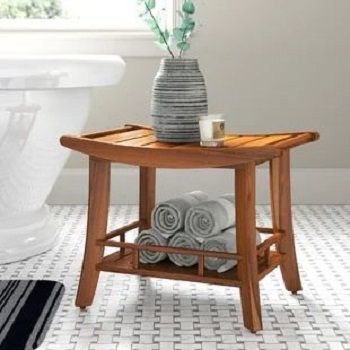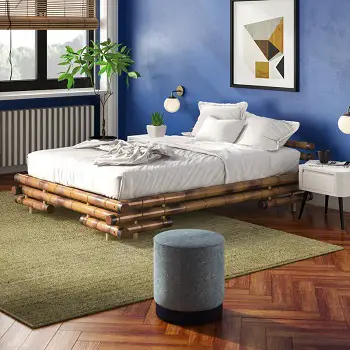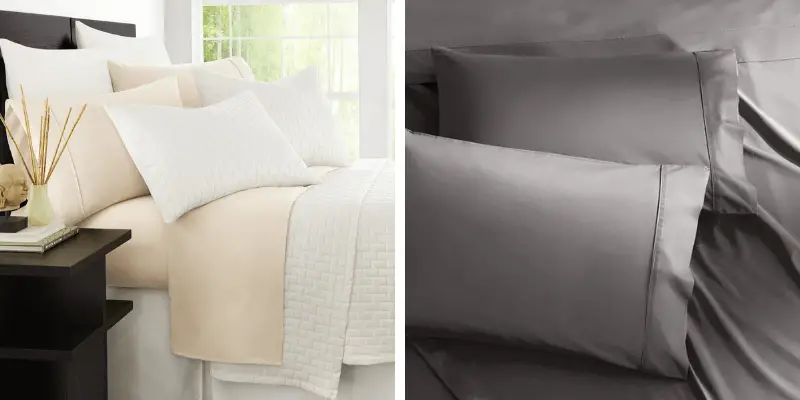Bamboo is a naturally sustainable plant that does not require fertilization and that pandas love to eat throughout the day. Rayon is a cellular-style fiber that is categorized as a natural material derived from plants.
When you combine both bamboo and rayon the result is “bamboo rayon.” But what exactly is this uniquely combined material?
Bamboo rayon is a fabric manufactured from bamboo plant fibers and purified cellulose derived from plant sources. It wears and drapes smoothly and feels like real silk or linen. Due to its benefits, bamboo rayon has become a popular fabric used to make bed sheets and pillows.
To understand this beautifully exclusive material, let’s talk about its history, production, benefits, and how bamboo rayon compares to cotton.
The term “viscose” is often used around products made from bamboo rayon. It is a semi-synthetic type of rayon fabric made from natural raw wood pulp like bamboo.
Bamboo Rayon History
Bamboo rayon was introduced into the United States from China around the beginning of the decade.
It is called the first-generation fabric. China wanted a fabric that is as soft as silk but which can be manufactured cheaper.
Bamboo rayon fabrics were used in the 1980s in Asia and parts of Europe. Because of its anti-bacterial properties, it was popularly advertised in the clothing industry.
Modern advertisements for bamboo rayon are used in baby products like diapers because of its absorbability, breathability, softness, and tenderness next to the skin.

Bamboo Rayon Production
Let’s be honest! Just a few years ago, the production or manufacturing of bamboo rayon was not an eco-friendly process. To give this fabric its soft texture many chemicals and solvents were used. Unfortunately, this chemical waste was released into the air and water.
However, with modern technology, bamboo rayon products are manufactured with an eco-friendly process. To begin with, chemicals or harsh solvents are no longer being used. The natural enzyme waste from creating bamboo rayon clothing and household products is reusable and is good for the environment. The use of modern processes helps to create higher-quality bamboo rayon material.
Benefits of Bamboo Rayon
Bamboo rayon is a popular fabric that is growing in popularity and is used in a myriad of products, that include the following:
- Every day wear
- Outerwear
- Spools of yarn
- Upholstery material
- Carpet material
- Bedding
- Towels, etc.
Due to its softness and durability, bamboo rayon is commonly used in clothing and bedding. Bamboo rayon is soft next to the skin. It is non-allergenic. As such, it is used more often to make pillow covers, blankets, duvets, underwear, socks, t-shirts, and more.
Bamboo rayon products are naturally hypoallergenic, temperature-controlled, wicks away moisture or dampness, as well as resisting bacteria that cause odor. Due to the marriage of bamboo and rayon, the products made from its properties are long-lasting.
Clothing designers love this material combination because it is easy to work with. Bamboo rayon is durable enough to be worn all day without snagging or wrinkling. Bamboo rayon is easy to dye, and it is washable.
Also, if you missed this product during the COVID-19 pandemic, a bamboo rayon face mask was on the market. It was advertised as keeping sweat away, keeping the skin cool all day, and is comfortable to wear. The antimicrobial-treated bamboo rayon mask fabrics were designed to help to block ill-favored air particles from entering your airways.
In addition to being made into a COVID mask, this topic leads to its use in medical supplies due to its antibacterial properties. Not many people realize that bamboo rayon and other bamboo fabrics are used to produce sanitary products and hygienic medical supplies. These can include medical-surgical masks, sanitary towels, medical pads, gauze, and outer surgical wear.
Bamboo Rayon vs Cotton
All types of fabrics feature pros and cons. Natural fibers like bamboo, rayon, and cotton have been used for years. Their longevity is because of the properties they have like breathability, softness, absorbency. These fibers are also biodegradable, and everyone can wear them even if they have sensitive skin.
Let’s look at the new bamboo rayon combination versus century’s old cotton fabrics:
- Durability: Bamboo rayon is proving to last a long time. Cotton clothing is featured in museums around the world so you can see how long it lasts.
- Texture: Egyptian cotton products are luxuriously soft. Even though bamboo rayon is the new kid on the block, its texture is soft and silky. Also, bamboo rayon is silkier to the touch than cotton. However, both cotton and bamboo rayon are temperature friendly, keeping you warm in the winter and cool in the warmer seasons.
- Product Engineering: Cotton is naturally grown. As its advertisement phrase indicates, “it is the fabric of our lives.” Cotton and many of its by-products are used in a variety of industries like medical, packaging, food, and cosmetics. The newness of bamboo rayon is yet to be determined. It does have its naysayers like the U.S. Federal Trade Commission (FTC). Since the U.S. government categorizes bamboo rayon as a man-made fiber, they believe it should be labeled differently than bamboo. It remains a source of discussion. Therefore, in the U.S. the FTC would like to classify it, under the name of rayon of bamboo. However, bamboo rayon is fast becoming a more popular fabric blend.
- Cost: Cotton costs vary, like a simple cotton dress is reasonable, while Egyptian cotton sheets are on the high side. Currently, bamboo rayon is an economical retail product. Bamboo rayon is cheaper to manufacture than cotton.
- Versatility: Both bamboo rayon and cotton are versatile fabrics even though cotton has far more innumerable benefits.
Both bamboo rayon and cotton are lightweight fabrics, plus they both protect against harsh sun rays.
Cotton has long been a favorite fabric among retail, commercial, and industrial industries. But rayon is similarly popular with its multi-purpose use in varying industries like aerospace engineering and NASA. When comparing both bamboo rayon and cotton, it is hard to choose a winner. The two fabrics are very similar. What is important, is that you will receive quality, softness, durability, and so much more from both.
Bamboo Group is a collaboration of individuals who love the world’s most sustainable and eco-friendly natural material. We believe every home can benefit from the natural colors and patterns of bamboo. We’re excited to see bamboo grow in popularity and get the recognition it deserves. Years of experience growing bamboo plants have taught us a lot we want to share with the world.



